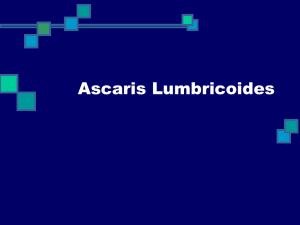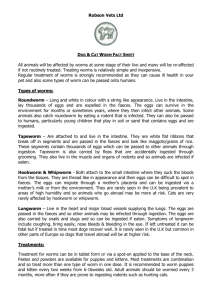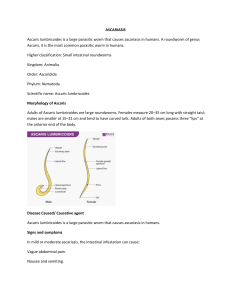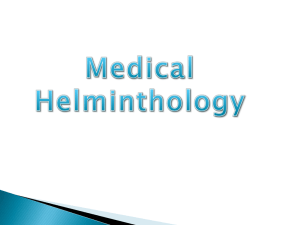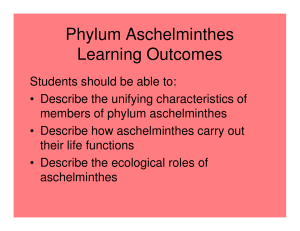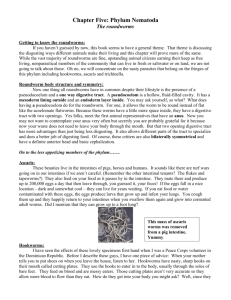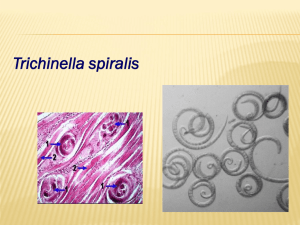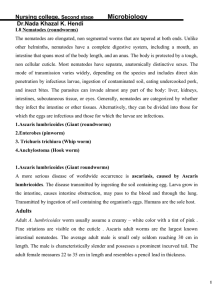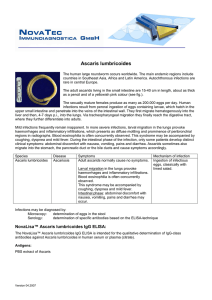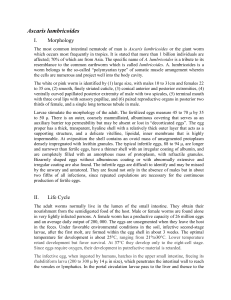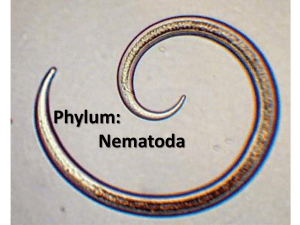ASCARIASIS
advertisement
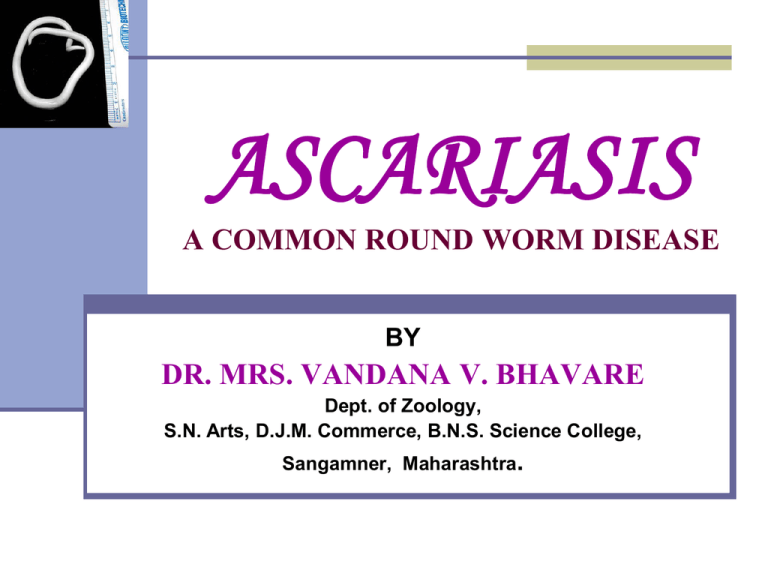
ASCARIASIS A COMMON ROUND WORM DISEASE BY DR. MRS. VANDANA V. BHAVARE Dept. of Zoology, S.N. Arts, D.J.M. Commerce, B.N.S. Science College, Sangamner, Maharashtra. INTRODUCTION Ascaris lumbricoides is the largest nematode (roundworm) parasitizing the human intestine. Ascaris lumbricoides is an intestinal worm found in the small intestine of man. They are more common in children then in adult. As many as 500 to 5000 adult worms may inhabit a single host. Geographic Distribution The most common human helminthic infection. Worldwide distribution. Highest prevalence in tropical and subtropical regions, and areas with inadequate sanitation. MORPHOLOGY It is a elongated, cylindrical and tapering at both ends. Sexes are separate The female is longer than male 20 – 35 cm long, 4-6 mm in diameter. Male is smaller being 15-30 cm long, 2-4 mm in diameter. The posterior end of male is curved having penial setae near the end. The Mouth Parts The mouth opens at the anterior end. It is surrounded by three finely toothed lips. The lips are one dorsal and two ventrolateral. These lips bear sensory structures called labial papillae The dorsal lip has two double sensory papillae and ventrolateral lip has one double sensory papilla. The ventrolateral lip also bear amphidial gland which is olfactory and chemoreceptor INFECTION TO MAN It occurs when the man swallows the infective eggs of Ascaris with contaminated food or water. The Egg of Ascaris LIFE CYCLE Adult worms live in the lumen of the small intestine. A female may produce approximately 200,000 eggs per day, which are passed with the faeces . Unfertilized eggs may be ingested but are not infective. Fertile eggs embryonate and become infective after 18 days to several weeks. After infective eggs are swallowed , the larvae hatch , invade the intestinal mucosa. Carried via the portal, then systemic circulation to the lungs. larvae mature further in the lungs (10 to 14 days), penetrate the alveolar walls, ascend the bronchial tree to the throat, and are swallowed. Upon reaching the small intestine, they develop into adult worms. Between 2 and 3 months are required from ingestion of the infective eggs to oviposition by the adult female. Adult worms can live 1 to 2 years. Rhabditiform larvae Egg hatch------3rd stage larva --- hepatic portal vessels to liver (3-4 days) -----Hepatic vein ------ Post caval vein ----Heart --- Lungs (7days-3rd moulting) --Larynx --- oesophagus --- Stomach (4th moulting) Symptoms of Ascariasis No symptoms Stage 1: worm larvae in the bowels attach to bowel walls Stage 2: worm larvae migrate into the lungs: Fever and breathing difficulty Coughing and pneumonia Stage 3: worms enter the small intestine and mature into worms and remain there to feed Abdominal symptoms Abdominal discomfort Intestinal blockage - may be partial or complete Partial intestinal blockage Total intestinal blockage Severe abdominal pain Vomiting Restlessness Disturbed sleep Worm in stool Worm in vomit CLINICAL FEATURES Abdominal pain, diarrhoea, vomiting and slight temperature. It blocks intestine and appendix. They may enter bile or pancreatic duct and interfere with digestion. Injure the intestine and cause peritonitis. They produce toxins which irritate the mucous membrane of the gut, or prevent digestion of protein by host by destroying an enzyme trypsin. In children they cause stunted growth and makes the mental capacity dull. Larvae causes inflammation and haemorrhage in the lungs which results in pneumonia – may prove fatal. Treatment Infections with A.lumbricoides are easily treated with a number of anthelmintic drugs: pyrantel pamoate given as a single dose of 10 mg/kg. levamisole given as a single dose of 2.5 mg/kg. mebendazole given as a single dose of 500 mg. albendazole given as a single dose of 400 mg. PREVENTION Keeping good sanitation conditions is the only way to prevent the infection of Ascaris. Pollution of soil with human faeces should be avoided. Vegetable should be thoroughly washed in a mild solution of Pottasium permanganate and properly cooked before use. Finger nails should be regularly cut to avoid the collection of dirt and eggs below them. Hands should be properly washed with some antiseptic soap before touching edibles or eating. REFERENCES Medical parasitology by Chatterjee www.pubmedcentral.nih.gov/ articlerender.fcgi?artid www.websters-onlinedictionary.org/As/Ascaris.html emedicine.medscape.com/article
